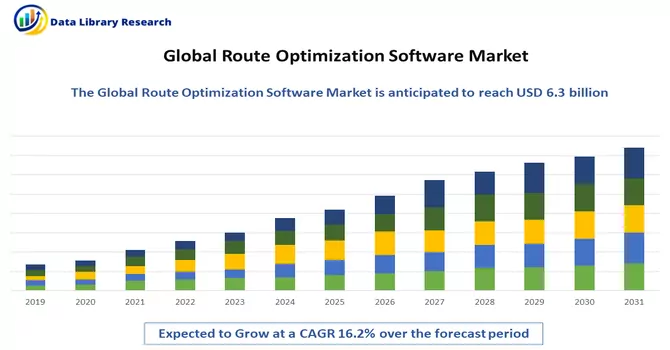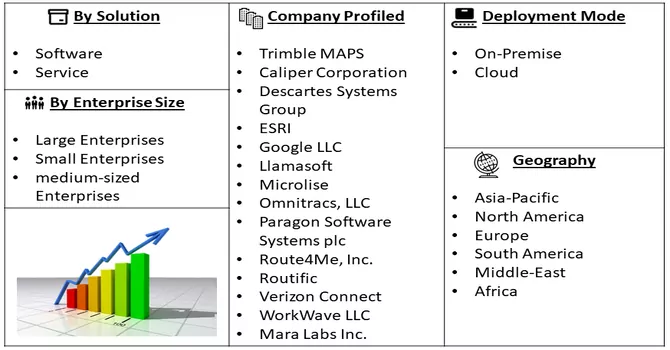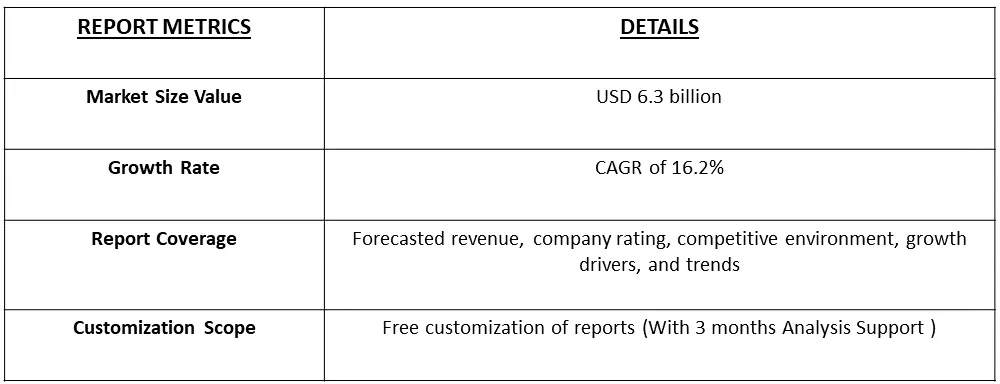The global route optimization software market size was valued at USD 6.3 billion in 2023 and is expected to grow at a compound annual growth rate (CAGR) of 16.2% from 2024 to 2031.

Get Complete Analysis Of The Report - Download Free Sample PDF
Route optimization refers to the process of finding the most efficient and cost-effective route for a given set of destinations or waypoints. This concept is particularly relevant in logistics, transportation, and fleet management, where companies aim to streamline their delivery or service routes to minimize travel time, fuel consumption, and overall operational costs. The goal of route optimization is to enhance resource utilization, improve delivery or service time, and reduce unnecessary expenses. Various factors are taken into consideration during the optimization process, including traffic conditions, vehicle capacities, delivery windows, and any other relevant constraints. By leveraging algorithms and mathematical models, route optimization software can provide optimal paths or schedules for vehicles, helping businesses enhance their overall efficiency and customer satisfaction.
The anticipated growth in route optimization is driven by the rising demand for effective transportation management. With the global population expanding and urbanization advancing rapidly, transportation systems encounter substantial challenges such as congestion, delays, and operational inefficiencies. In this context, route optimization software emerges as a viable solution to address these issues by offering the shortest and quickest routes. By optimizing delivery timelines, minimizing travel time, and enhancing overall transportation efficiency, this software becomes a crucial tool for mitigating challenges associated with the increasing demands on transportation infrastructure. As urban areas continue to evolve and face complex mobility issues, the adoption of route optimization technology becomes imperative for businesses seeking to navigate and streamline their logistics operations in an ever-growing and dynamic environment.
The route optimization market is evolving with several key trends. The adoption of cloud-based solutions is on the rise, providing flexibility and real-time updates. Advanced technologies like AI and ML are increasingly integrated, enabling dynamic route planning and continuous efficiency improvements. Last-mile optimization is gaining prominence with the growth of e-commerce, focusing on reducing delivery times and costs. Sustainability is a key consideration, with route optimization aligning with eco-friendly practices to minimize fuel consumption and carbon emissions. IoT integration allows real-time tracking of vehicles, enhancing accuracy in route planning. Customization and scalability are essential features, catering to businesses of varying sizes. Competitive pricing models encourage adoption, making route optimization accessible to a broader range of enterprises. The global expansion of e-commerce continues to drive the demand for efficient route planning. Regulatory compliance features are being integrated to ensure adherence to transportation regulations. Collaboration with mobile app platforms enhances the overall customer experience, providing real-time tracking information and improving transparency in delivery operations.
Market Segmentation: The Route Optimization Software Market is Segmented by Solution (Software, and Service), Deployment Mode (On-Premise, and Cloud), Enterprise Size (Large Enterprises, and Small and medium-sized Enterprises), and Geography (North America, Europe, Asia-Pacific, Middle-East and Africa, and South America). The report offers the value (in USD million) for the above segments.

For Detailed Market Segmentation - Download Free Sample PDF
Market Drivers:
Rising Global E-commerce Demand
The exponential growth of global e-commerce has become a significant driver for the route optimization software market. With an increasing number of businesses offering online services, there is a higher demand for efficient and timely deliveries. Route optimization software plays a crucial role in optimizing delivery routes, reducing transit times, and enhancing overall operational efficiency. The need for businesses to meet customer expectations for fast and reliable deliveries has led to a surge in the adoption of route optimization solutions. As the e-commerce sector continues to expand, the demand for route optimization software is expected to remain robust.
Focus on Cost Efficiency and Sustainability
Businesses across various industries are placing a heightened emphasis on cost efficiency and sustainability in their operations. Route optimization software addresses both of these concerns by minimizing fuel consumption, reducing vehicle wear and tear, and optimizing overall resource utilization. By providing the most efficient routes, businesses can cut down on operational costs, improve fuel efficiency, and reduce their environmental impact. The dual benefit of cost savings and sustainability aligns with the broader corporate goals of efficiency and environmental responsibility, making route optimization software a strategic investment for companies aiming to enhance their operational and ecological footprint.
Market Restraints:
Integration Challenges and Initial Implementation Costs
One significant restraint in the route optimization software market is the challenge associated with integrating these solutions into existing operational systems. Implementing route optimization software often requires seamless integration with various technologies, such as GPS systems, fleet management tools, and enterprise resource planning (ERP) systems. Achieving this integration can be complex and may pose challenges for businesses, particularly those with legacy systems. Additionally, the initial implementation costs, including software licensing, hardware upgrades, and employee training, can be substantial. These factors may act as barriers for some businesses, especially smaller enterprises with limited resources, potentially slowing down the widespread adoption of route optimization software. Despite the long-term benefits, the upfront investment and integration complexities remain noteworthy challenges for market expansion.
The COVID-19 pandemic significantly impacted the route optimization software market, presenting both challenges and opportunities. Disruptions in global supply chains and increased operational volatility posed challenges as route optimization software struggled to adapt to sudden shifts in demand and delivery patterns. However, the pandemic accelerated the adoption of e-commerce and last-mile delivery, creating opportunities for route optimization solutions to streamline operations, enhance efficiency, and facilitate contactless deliveries. The focus on remote work solutions also showcased the resilience of the route optimization technology. Despite challenges, the pandemic underscored the importance of route optimization software in navigating uncertainties and optimizing logistics in a rapidly changing business landscape.
Segmental Analysis:
Software Segment is Expected to Witness Significant Growth Over the Forecast Period
The software and route optimization market has witnessed dynamic growth driven by technological advancements and the increasing demand for streamlined logistics and transportation operations. As businesses globally strive for operational efficiency, route optimization software has become a critical tool for optimizing delivery routes, reducing transit times, and minimizing operational costs. The integration of advanced technologies such as artificial intelligence and machine learning has enhanced the capabilities of route optimization solutions, allowing for real-time adaptability to changing conditions and improving overall efficiency. With the surge in e-commerce activities and the need for last-mile delivery solutions, the software and route optimization market is experiencing a heightened demand, especially in sectors like retail, transportation, and supply chain management. The market is characterized by a competitive landscape with key players focusing on continuous innovation and product development to stay ahead in meeting the evolving needs of businesses seeking to enhance their logistics and operational capabilities. As industries increasingly recognize the importance of efficient route planning, the software and route optimization market is poised for further expansion and evolution in the coming years.
Cloud Based Segment is Expected to Witness Significant Growth Over the Forecast Period
The intersection of cloud-based technology and the route optimization market has ushered in a new era of efficiency and flexibility in logistics and transportation management. Cloud-based route optimization solutions leverage the power of remote servers to store and process data, enabling real-time updates, accessibility from various devices, and seamless integration with other software systems. This shift to cloud infrastructure addresses the need for scalable and agile solutions, providing businesses with the ability to adapt to changing conditions swiftly. In the route optimization market, cloud-based platforms have become increasingly popular due to their ability to handle complex algorithms and large datasets, essential for optimizing routes based on factors like traffic conditions, delivery windows, and vehicle capacities. This technology not only enhances the scalability and accessibility of route optimization tools but also facilitates collaborative efforts and data-driven decision-making. As the demand for efficient and dynamic route planning continues to grow, cloud-based solutions are expected to play a pivotal role in shaping the future of the route optimization market, offering businesses a more streamlined and responsive approach to managing their transportation and logistics operations.
Small and Medium Enterprise Company Segment is Expected to Witness Significant Growth Over the Forecast Period
Cloud-based route optimization solutions are proving to be particularly beneficial for Small and Medium Enterprises (SMEs) in the transportation and logistics sector. These businesses, often characterized by limited resources, find cloud-based platforms to be cost-effective and scalable solutions for managing their route planning and optimization needs. Cloud-based route optimization eliminates the need for extensive IT infrastructure investments, offering SMEs the flexibility to access advanced optimization tools without a significant upfront cost. For SMEs with dynamic and evolving logistics requirements, cloud-based solutions provide real-time updates and adaptability to changing conditions. This is crucial for small and medium-sized businesses that may experience fluctuations in delivery volumes, varying routes, or shifting customer demands. The scalability of cloud platforms allows SMEs to adjust their usage based on their specific needs, making it a more financially viable option. Moreover, the accessibility of cloud-based route optimization tools from various devices facilitates on-the-go decision-making for SMEs, enabling them to efficiently manage their fleet and improve overall operational efficiency. The collaborative nature of cloud platforms also encourages teamwork and communication within small and medium-sized enterprises, enhancing coordination among teams responsible for route planning, logistics, and delivery. As the cloud-based route optimization market continues to evolve, SMEs are likely to play a crucial role in driving its growth. The adoption of these solutions empowers smaller businesses to compete more effectively in the ever-evolving landscape of transportation and logistics by harnessing the advantages of advanced route optimization technology without the burden of substantial investments in traditional IT infrastructure.
North America Region Segment is Expected to Witness Significant Growth Over the Forecast Period
In North America, the adoption of cloud-based route optimization tools has become instrumental in revolutionizing the logistics and transportation landscape. With a robust and technologically advanced business environment, North American enterprises are increasingly turning to cloud solutions for efficient route planning and optimization. The cloud-based route optimization market in North America is witnessing significant growth, driven by the need for real-time adaptability, scalability, and cost-effective solutions in the transportation sector. One key factor contributing to the popularity of cloud-based tools in North America is the region's expansive geography and diverse transportation networks. Cloud platforms offer the flexibility to handle large datasets, intricate algorithms, and dynamic variables, optimizing routes based on real-time traffic, weather conditions, and delivery constraints. This adaptability is crucial for addressing the complexities of North America's vast and varied logistics requirements. Additionally, the competitive nature of industries such as e-commerce, retail, and distribution in North America has spurred the demand for efficient route optimization tools. Cloud-based solutions enable businesses to stay agile and responsive to changing market dynamics, providing a competitive edge in delivering timely and cost-effective services. The accessibility of cloud-based route optimization tools from multiple devices allows logistics professionals in North America to make informed decisions on the go, enhancing overall operational efficiency. Furthermore, the collaborative features of these platforms facilitate seamless communication and coordination among stakeholders involved in route planning, logistics, and fleet management. As North American businesses continue to prioritize digital transformation and operational efficiency, the cloud-based route optimization market is poised for sustained growth. The region's inclination toward adopting cutting-edge technologies, coupled with the need for streamlined transportation operations, positions cloud-based route optimization tools as a key driver in shaping the future of logistics in North America.

Get Complete Analysis Of The Report - Download Free Sample PDF
The route optimization software market is characterized by fragmentation and is poised for intense competition, primarily due to the presence of prominent players. Major industry participants are making substantial investments in the launch of new products that incorporate cutting-edge technologies within route optimization software. These strategic initiatives signify a concerted effort by key market players to stay at the forefront of innovation, ensuring that their offerings align with the latest advancements in the field. The emphasis on integrating advanced technologies underscores a commitment to providing businesses with more sophisticated and efficient solutions, thereby contributing to the dynamic evolution of the market. As a result, customers can expect a continual influx of innovative products and features as companies vie for market share in this competitive landscape. Some prominent players in the global route optimization software market include:
Recent Development:
1) In January 2024, OnTerra Systems, the creators of RouteSavvy route planning software, unveiled RouteSavvy API PLUS, a sophisticated Application Programming Interface (API) built upon the robust route optimization platform integral to RouteSavvy. Tailored for software developers seeking to integrate advanced route optimization capabilities into their applications, RouteSavvy API PLUS offers enhanced features, including Multi-vehicle Route Optimization and Time Windows functionality. With a starting cost of USD100 per month, the API can efficiently process up to 1000 stops distributed across a maximum of 50 routes. This innovative introduction is poised to make a significant impact on the route optimization software market by providing developers with a powerful and customizable toolset. The inclusion of advanced functionalities such as Multi-vehicle Route Optimization and Time Windows reflects a response to the growing demand for sophisticated routing solutions, contributing to the market's evolution and meeting the dynamic needs of businesses aiming to streamline their logistics operations.
2) In October 2023, Fraunhofer IPA in Stuttgart, Germany, had developed autonomous outdoor navigation technology capable of addressing various challenges for outdoor navigation. This innovation allowed agricultural robots, exemplified by prototypes like 'CURT,' to engage in tasks such as mechanical weed control. At the Agritechnica trade fair, two robots, including CURTdiff, were showcased. CURTdiff demonstrated autonomous recognition of crop rows and the ability to navigate them independently, particularly in practices like potato and asparagus cultivation. This technological advancement, witnessed at the trade fair, not only highlighted breakthroughs in outdoor navigation but also foreshadowed contributions to the growth of the Route Optimization Software market. As agricultural robots played an expanding role, the demand for advanced route optimization solutions surged to streamline and enhance the efficiency of these autonomous operations in the field of precision agriculture.
Q1. What was the Route Optimization Software Market size in 2023?
As per Data Library Research the global route optimization software market size was valued at USD 6.3 billion in 2023.
Q2. What is the Growth Rate of the Route Optimization Software Market?
Route Optimization Software Market is expected to grow at a compound annual growth rate (CAGR) of 16.2% over the forecast period.
Q3. What segments are covered in the Route Optimization Software Market Report?
By Solution, By Deployment mode, Enterprise size and Geography are the segments covered in the Route Optimization Software Market Report.
Q4. Who are the key players in Route Optimization Software Market?
Some key players operating in the market include
Data Library Research are conducted by industry experts who offer insight on industry structure, market segmentations technology assessment and competitive landscape (CL), and penetration, as well as on emerging trends. Their analysis is based on primary interviews (~ 80%) and secondary research (~ 20%) as well as years of professional expertise in their respective industries. Adding to this, by analysing historical trends and current market positions, our analysts predict where the market will be headed for the next five years. Furthermore, the varying trends of segment & categories geographically presented are also studied and the estimated based on the primary & secondary research.
In this particular report from the supply side Data Library Research has conducted primary surveys (interviews) with the key level executives (VP, CEO’s, Marketing Director, Business Development Manager and SOFT) of the companies that active & prominent as well as the midsized organization
FIGURE 1: DLR RESEARH PROCESS

Extensive primary research was conducted to gain a deeper insight of the market and industry performance. The analysis is based on both primary and secondary research as well as years of professional expertise in the respective industries.
In addition to analysing current and historical trends, our analysts predict where the market is headed over the next five years.
It varies by segment for these categories geographically presented in the list of market tables. Speaking about this particular report we have conducted primary surveys (interviews) with the key level executives (VP, CEO’s, Marketing Director, Business Development Manager and many more) of the major players active in the market.
Secondary ResearchSecondary research was mainly used to collect and identify information useful for the extensive, technical, market-oriented, and Friend’s study of the Global Extra Neutral Alcohol. It was also used to obtain key information about major players, market classification and segmentation according to the industry trends, geographical markets, and developments related to the market and technology perspectives. For this study, analysts have gathered information from various credible sources, such as annual reports, sec filings, journals, white papers, SOFT presentations, and company web sites.
Market Size EstimationBoth, top-down and bottom-up approaches were used to estimate and validate the size of the Global market and to estimate the size of various other dependent submarkets in the overall Extra Neutral Alcohol. The key players in the market were identified through secondary research and their market contributions in the respective geographies were determined through primary and secondary research.
Forecast Model
